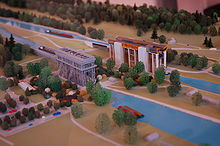Classification of European Inland Waterways

The Classification of European Inland Waterways is a set of standards for interoperability of large navigable waterways forming part of the Trans-European Inland Waterway network within Continental Europe and Russia. It was created by the European Conference of Ministers of Transport (ECMT; French: Conférence européenne des ministres des Transports, CEMT) in 1992,[1] hence the range of dimensions are also referred to as CEMT Class I–VII.
The size for each waterway is limited by the dimensions of the structures including the locks and boat lifts on the route.
Classification
Class I corresponds to the historical Freycinet gauge decreed in France during 1879. The larger river classification sizes are focused on the carriage of intermodal containers in convoys of barges propelled by a push-tug. Most of the canals of the United Kingdom have smaller locks and would fall below the dimensions in the European classification system. In 2004, the standards were extended with four smaller sizes RA–RD covering recreational craft, which had originally been developed and proposed via PIANC.[2] The proposal to add the recreational sizes was adopted by United Nations Economic Commission for Europe resolution 52.[3][4] In 2015 an updated version was published.[5]
| Type of inland waterways |
Classes of navigable waterways |
Motor vessels and barges | Pushed convoys | Minimum height under bridges (m) | |||||||
|---|---|---|---|---|---|---|---|---|---|---|---|
| Designation | Length (m) | Breadth (m) | Draught (m) | Tonnage (t) | Length (m) | Breadth (m) | Draught (m) | Tonnage (t) | |||
| For recreational navigation |
RA | Open boat | 5.5 | 2.00 | 0.50 | 2.00 | |||||
| RB | Cabin cruiser | 9.5 | 3.00 | 1.00 | 3.25 | ||||||
| RC | Motor yacht | 15.0 | 4.00 | 1.50 | 4.00 | ||||||
| RD | Sailing boat | 15.0 | 4.00 | 2.10 | 30.00 | ||||||
| Of regional importance to east of Elbe |
I | Gross Finnow | 41 | 4.7 | 1.40 | 180 | 3.0 | ||||
| II | BM–500 | 57 | 7.5–9.0 | 1.60 | 500–630 | ||||||
| III | 67–70 | 8.2–9.0 | 1.60–2.00 | 470–700 | 118–132 | 8.2–9.0 | 1.6–2.0 | 1,000–1,200 | 4.0 | ||
| Of regional importance to west of Elbe |
I | Barge | 38.5 | 5.05 | 1.80–2.20 | 250–400 | |||||
| II | Kampine-Barge | 50.0–55.0 | 6.6 | 2.50 | 400–650 | 4.0–5.0 | |||||
| III | Gustav Koenigs | 67.0–80.0 | 8.2 | 2.50 | 650–1,000 | ||||||
| Of international importance |
IV | Johann Welker | 80.0–85.0 | 9.5 | 2.50 | 1,000–1,500 | 85 | 9.5 | 2.5–2.8 | 1,250–1,450 | 5.25 or 7.00 |
| Va | Large Rhine class | 95–110 | 11.4 | 2.5–4.5 | 1,600–3,000 | 5.25 or 7.00 or 9.10 | |||||
| Vb | 1×2 convoy | 172–185 | 3,200–6,000 | ||||||||
| VIa | 2×1 convoy | 95–110 | 22.8 | 7.00 or 9.10 | |||||||
| VIb | 2×2 convoy | 140.0 | 15.0 | 3.90 | 185–195 | 6,400–12,000 | |||||
| VIc | 2×3 convoy | 270–280 | 2.5–4.0 | 9,600–18,000 | 9.10 | ||||||
| 3×2 convoy | 195–200 | 33.0–34.2 | 2.5–4.5 | ||||||||
| VII | 3×3 convoy | 285 | 14,500–27,000 | ||||||||
See also
- Unified Deep Water System of European Russia (110-210m length max, 2,5-4m draft)
- Baltimax (15,2m draft, the same as NeoPanamax)
- Bangkok Port (172m length, 25m beam -with special permit 30m-, 8,2m draft), Bangkokmax of 1944 TEU
- Seawaymax (USA Great Lakes docks, 8,08m draft), Chesapeake & Delaware Canal (draft 10,7m)
- Paraguay River (almost 2,5m in middle river, 1,6m in upper river)
- Grand Canal (China)
- Saimaa Canal (Finland, max length 82,5 m, beam 12,6m, draft 4,2m)
- Rhine–Main–Danube Canal for ships of 110x11,45x2,5m (up to 135m length with a special permit)
References
- ^ European Conference of Ministers of Transport (12 June 1992). Resolution No. 92/2 on New Classification of Inland Waterways (PDF) (Report). Retrieved 2018-08-30.
- ^ RecCom Working Group 8 (2000). Standards for the Use of Inland Waterways by Recreational Craft (Report). PIANC. pp. 30–32. ISBN 2-87223-115-3. Retrieved 11 July 2012.
{{cite report}}: CS1 maint: numeric names: authors list (link) - ^ Edwards-May, David (3 July 2007). Classification of Recreational waterways (PDF) (Report). Lille: Stichting Recreatietoervaart Nederland. Retrieved 11 July 2012.[permanent dead link]
- ^ Working Party on Inland Water Transport (19 November 2004). "Resolution No.52" (PDF). European Recreational Inland Navigation Network. Geneva: Economic Commission for Europe Inland Transport Committee.
- ^ "Inland Waterway Transport in Europe: no significant improvements in modal share and navigability conditions since 2001" (PDF). European Court of Auditors. Luxembourg: Luxembourg: Publications Office of the European Union. 2015. p. 37. doi:10.2865/158305. ISBN 978-92-872-1948-0. ISSN 1977-5679. Archived (PDF) from the original on 2015-03-18. Retrieved 27 December 2021.
Publications including the full classification table
- Waterway article including a reference to the European classification
- Map of the European Inland Waterway Network, United Nations Economic Commission for Europe (4th edition, Geneva 2012), without the recreational navigation categories. Waterway Standards.
- European Waterways Map and Directory, 5th ed., David Edwards-May (Transmanche, 2014), ISBN 979-1-094429-00-6
You can help expand this article with text translated from the corresponding article in Czech. (December 2022) Click [show] for important translation instructions.
|
